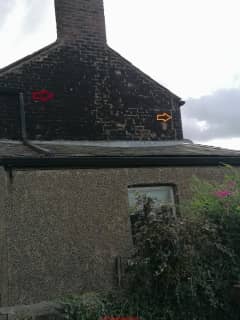 Stains on Brick Surfaces FAQs
Stains on Brick Surfaces FAQs
Q&A: identify, clean, prevent stains on brick surfaces
- POST a QUESTION or COMMENT about the cause, removal or prevention of staining on brick surfaces
Stains & discoloration on brick surfaces:
This article describes the causes & cures for various types of stains found on brick surfaces both outdoors and indoors. We list the common sources of stains on brick chimneys, walls, walks, and ceilings.
The article distinguishes among common brick stain sources such as algae, bacteria, lichens, moss, soot, sulphur, fungal growth, and other causes of markings on brick.
InspectAPedia tolerates no conflicts of interest. We have no relationship with advertisers, products, or services discussed at this website.
- Daniel Friedman, Publisher/Editor/Author - See WHO ARE WE?
Stains on Brick Surfaces
 These questions and answers about identifying, removing, and preventing all sorts of stains or discolorations or deposits on brick surfaces were posted originally
These questions and answers about identifying, removing, and preventing all sorts of stains or discolorations or deposits on brick surfaces were posted originally
at STAINS on BRICK SURFACES; you should be sure to review that article.
[Click to enlarge any image]
On 2019-09-08 by Bex - Black stains on brick home in Stockport, Manchester, England
Thanks for taking the time to look at the pics and for your advice.
On 2019-09-08 (mod) - can anyone tell me what this black stuff is on the brick?
That gable end looks like a tar coating, as I suggested; an up-close look, when that's possible, will confirm that - or not.
Some of the other dark areas on the brick could certainly be an algae - more common in areas that are shaded and damp or low on the walls near ground where there has been wetting from rain splash-up.
Higher on the walls where black vertical streaks originate just under the gutters I suspect there have been either gutter leaks or ice dam leaks sending water down the walls of the home.
It's common to find a vertical streak down a wall from roof edge marks the location of a gutter overflow or leak.
Beware of frost damage in those areas as well as leaks into the interior of the building.
I marked the tarry coating with a yellow arrow.
Watch out: that repaired vertical joint marked by the red arrow tells us that this home's wall has leaned outwards at the top.
I take it your Stockport is outside of Manchester in England, not Stockport Mass. in the U.S.
If there are not leaks into the building and if there is not ongoing movement we're principally discussing a cosmetic issue and maintenance issues.
For a house that's over 150 years old I'm not shocked that there has been movement and prior repairs.
You will want to contact RICS (Royal Institute of Chartered Surveyors) to hire a chartered surveyor with expertise on older brick homes and to have a thorough inspection so that you'll know what maintenance and repair are in store for a new owner.
Contact information for RICS is at HOME INSPECTORS UK & OTHER COUNTRIES
Let us know what your surveyor reports.
On 2019-09-08 by Bex
Photos of the black "stains" on my brick home. The photo [above] shows a very thick black substance on the gable end of the home.
Just below is a photo of a black vertical streak down the wall beginning at the wall top below the eaves trough or gutter.
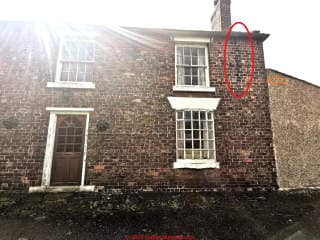
The photo below shows vertical streaks of black down the brick walls of the home, originating just under the gutters.
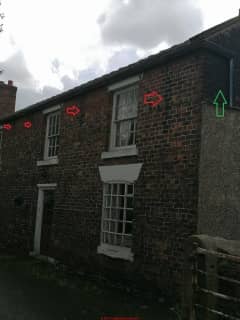
On 2019-09-08 by Bex
Here is a photo of our brick home showing dark black discolouration on bricks near the wall top.
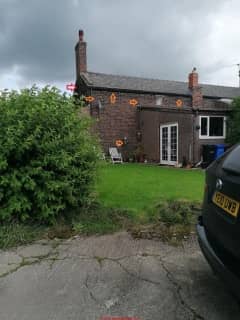
It's an 1850s house on a farm in Stockport. It's semi detached. Thanks for extra info about the movement.
I did detect a slope in one of the bedrooms from the back of the room down towards the front exterior wall. Please can I submit more pics of the front and rear elevations for you to look at?
On 2019-09-07 by (mod) - tarred brick wall at gable end
Bex
A closer look would be more diagnostic but my guess is that the gable end wall has been coated with tar or an asphalt-mix in an effort to seal against water penetration through the brick.
Look inside for signs of a history of water entry.
Watch out: that roughly-vertical repair joint at the upper right vertical wall above the lower low-slope roof line in your photo suggests that the whole front wall of the home may have been moving - leaning. Look inside too for signs of movement, prior damage, repairs, and signs of ongoing movement.
That lower slope, if it has asphalt shingles or slate without a waterproof underlaying membrane, may be a leaky roof too.
What are the country and city where this home is located?
What is the age of the home?
On 2019-09-07 by Bex
Please can anyone tell me what this black stuff is on the brick? Looking at buying the house, but puzzled by the black staining.
On 2019-08-17 by (mod) - how do we clean off these red stains on brick?
 Linda:
Linda:
Detailed advice for your question is now at
RED STAINS on BRICK - RUST? - please take a look
https://inspectapedia.com/exterior/Stains_on_Brick.php#Red
You may need to clear your browser cache to see the updated page
On 2019-08-15 by Linda
We think this is RUST from the above sign. Tried CLR and tried MURIATIC ACID, but after hours of scrubbing are still left with this! HELP!
On 2019-06-13 by (mod) -
There could be water leaking through stucco coating and corroding something behind it such as supporting lath. It'd be diagnostic to know more about the building: age, location - country, city, state or province, type of stucco
Typically I think these stains are algae bleeding down but yours seem to originate in a horizontal row - suggesting construction materials and leaks could be a factor.
In the INDEX to RELATED ARTICLES found at the end of this article you'll find better diagnostics for your case at STAINS ON STUCCO
On 2019-06-12 by Mark Pankratz
What is the green stains on the outside of my fireplace? They start at a point and bleed downward.
IMAGE LOST by older version of Comments code - now fixed. Please re-post the image if you can. Sorry. Mod.
On 2019-03-28 by (mod) - chimney losing bricks
Joey
I can't make a confident diagnosis from just a brief text, but typically when a chimney is losing bricks it's because of cracks and lost mortar, water and frost damage.
Watch out: a more serious concern is if the chimney flue itself is damaged - that can show up as brown creosote stains on the chimney exterior. A damaged flue is unsafe as it can leak dangerous flue gases into the building, leak a spark and start a fire, or draw poorly and cause unsafe heater operation.
So it'd be smart to get the flue as well as chimney exterior inspected by a certified chimney sweep.
On 2019-03-27 by Joey
I presently have one brick on my outside chimney slope missing, bricks above and below are darkened. What causes bricks to darken, loosen and fall off ?
On 2018-11-21 by (mod) -
Mahmood
Regarding the dark red stains on the center of the brick window sill in your photo:
My best guess is that previously someone had a window air conditioner in the window in your photo and the A/C condensate rusted the air conditioner base and stained the brick as it drooled down the building wall.
If the red stains on the brick sill are from rust, try an iron or rust stain remover product.
The article STAINS on BRICK SURFACES discusses approaches to cleaning stains on brick as well as preventing their recurrence.
If the red stains on the brick sill in your photo are algae (which seems less likely given the circumstances portrayed in your photo, but still, not impossible), just about any household cleaner may remove it; use plenty of rinse water to avoid any bleach staining of the bricks below.
On 2018-09-15 by Mahmood
Our outer Brick walls few bricks stained along with window glass from outside due contineously dripping of A/C water. Kindly advice and help how to clean stains from bricks and glass.
IMAGE LOST by older version of Comments code - now fixed. Please re-post the image if you can. Sorry. Mod.
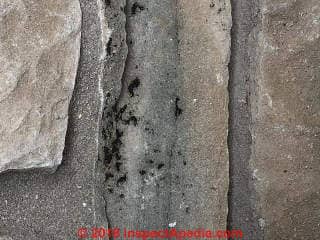 On 2018-09-05 by (mod) - greasy black spatter may be algae
On 2018-09-05 by (mod) - greasy black spatter may be algae
I can't say for sure
this could be
- algae
- mold
- asphalt or coating splash-up
- something else
On 2018-09-05 by Heather
Our front porch exterior bricks have numerous black grease looking splatters/spots [photo above].
Any idea what this may be? The rainge from a few inches to small pin size splatters and it isn’t all of the bricks but numerous. House is 14 yrs old.
On 2018-05-31 by (mod) -
Frank:
See MASONRY CLEANERS
and also contact:
- Prosco Corp, Sure Klean® New Masonry Cleaner, PROSOCO, Inc. 3741 Greenway Circle Lawrence, Kansas 66046 USA, Tel: 800-255-4255 Concentrated hydrogen chloride (HCL) and water, an acid for cleaning mortar smears and dirt from brick, tile, etc. "Safer than muriatic acid for new masonry surfaces"
Prosco produces a lime solvent, new masonryh cleaners, a cleaner for hard water deposits, a cleaner for metallic stains on masonry, marble cleaner, an asphalt and tar remover, iron stain remover, and paint strippers for masonry.
Prosco produces a huge line of masonry cleaner products. We suggest calling the company for advice if you are having trouble removing stains from masonry
On 2018-05-31 by (mod) - white stains on chimney may indicate dangerous conditions
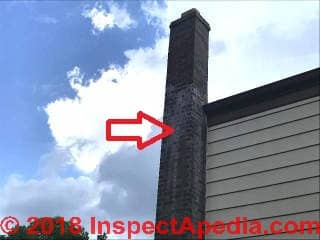 Frank:
Frank:
IMO in order of importance
1. Watch out: The chimney may be unsafe and thus a fire and carbon monoxide hazard to the building, particularly if any of the chimney surfaces are in contact with our built into the structure - its wall(s). The risk is a fire, spark, or flue gas leaking into the building.
In addition, if gas combustion itself is producing ANY soot, black or white, the heating equipment is very unsafe and should be shut down until it has been diagnosed and repaired. No gas appliance should ever produce black or white soot deposits.
Those indicate improper combustion, increasing the risk of a fatal carbon monoxide poisoning.
The experts, the CSIA, Chimney Safety Institute of America, point out that
"White stains (efflorescence) on the outside of the masonry chimney ... could point to a venting system problem. ... Eventually corrosion caused by this acidic water condensing inside the flue may cause the liner, mortar, and brickwork to flake and crumble.
Chimney sweeps often find this debris creating blockages in the flue, potentially exposing the occupants of the home to carbon monoxide and other dangerous combustion byproducts, a situation not to be taken lightly." - retrieved 2018/05/31, original source: http://www.csia.org/gas_fireplace.html
The right procedure is to first make the chimney safe, before working to remove ugly stains on its exterior.
That means a chimney flue and chimney exterior inspection followed by the necessary repairs. For your chimney from just your note and the photo I suspect the chimney may need to be re-lined and a cap installed - at the very least.
From your photo I can't see the chimney base - it looks unusual - with just a few inches in contact with the structure - leaving me with further questions:
2. What's the fuel? I presume you will confirm that the fuel is natural or LP gas as I don't see brown or black stains I'd associate with burning heating oil or wood.
Natural gas or LP gas would not itself produce a white residue in or on a chimney.
3. What are the white stains?
I'm doubtful that whoever told you the stains are a direct cause of exhaust gas "leaching" through flue liner seams is not speaking precisely nor technically correctly.
Who cares about being so picky? Well if we don't understand what's going on we don't understand the risks involved nor what to do about the stains on your chimney.
When LPG or NG are burned in a heating appliance, as flue gases pass up the chimney, particularly a cool masonry chimney such as yours, (tell me the country and city location) condensate forms inside the flue from moisture in the gas exhaust passing up the chimney.
That's because in perfect combustion burning NG or LPG produces CO2 and water vapor.
That water vapor condenses in the flue.
That condensate might indeed leak through chimney cracks and openings. That condensate is typically acidic and as elaborated in the current Wikipedia entry as I'll give below, so the condensate will not, in the real world, be just pure water.
Efflorescence is a general term for mineral deposits that form on masonry as water passes through the masonry and evaporates from its dry side, leaving an accumulation of salts or other chemicals that were either in the original condensate (or other water source) or chemicals that were dissolved out of the masonry (yours looks like brick, probably with a hard-fired clay flue tile liner and probably including concrete both as mortar between the brick courses and mortar, perhaps imperfectly installed, between the clay flue tile liner sections).
Your chimney has not cap and no visible top seal though I can't see the chimney crown, and I'm not even sure from the photo of all of the chimney construction details and materials.
If a chimney leak were just from rainwater blowing in at the chimney top or down its sides, the chemistry of the white efflorescence that would be produced would be principally determined by what the relatively soft (thus aggressive) rainwater could dissolve from the flue liner clay (not much as that's hard-fired), the concrete used in building the chimney, and the bricks themselves.
The "quality efflorescence cleaner" you tried was probably formulated with that chemistry in mind. It may not have had the necessary solvents to remove acidic deposits of the other chemicals in the condensate nor what those may have dissolved from the mortar, cement, and brick.
The chemistry of the water leaks in your chimney, if we accept your conclusion that the stains are from "exhaust gases leaching through the flue liner" would be more complicated. Keep in mind that exhaust gases don't leach through clay nor brick in any significant way at all.
That's because from your report, it's not rainwater: what's "leaching" would be condensate produced as water in the exhaust gas condenses inside the cool chimney flue as gases pass upwards from the heating appliance.
From the details of other contaminants in NG or LPG condensate you'll see that there is a virtual soup of organics and other substances.
Watch out: The CSIA also points out that
There are some chimney liners that are not compatible with gas appliances because of the material from which they are made. It is important to make sure that the lining system you purchase – or even the one that may currently be in your chimney – is appropriate for use with gas appliances.
Probably your chimney's clay liner is ok but that's another question to discuss with the certified chimney sweep.
Bottom line: so where are we?
I would talk with the chimney sweep as well as the manufacturer of a couple of other chimney stain removing products to discuss what we speculate is in your chimney's stains to see what they suggest. I'm sorry but I am not smart enough to have a sure-fire answer from just your note.
CHIMNEY STAINS & LEAKS https://inspectapedia.com/chimneys/Chimney_Stains_Leaks.php has more information on the the types and colors of stains that show up on chimneys.
There we'll ultimately add this discussion as it may prompt helpful comments from other readers who've dealt with the same situation.
What's in NG or LPG condensate before it has passed through masonry or other materials?
In general, gas condensate has a specific gravity ranging from 0.5 to 0.8, and is composed of hydrocarbons such as propane, butane, pentane, hexane, etc.
Natural gas compounds with more carbon atoms (e.g. pentane, or blends of butane, pentane and other hydrocarbons with additional carbon atoms) exist as liquids at ambient temperatures.[4] Additionally, condensate may contain additional impurities such as:[5][6][7]
- Hydrogen sulfide (H2S)
- Thiols traditionally also called mercaptans (denoted as RSH, where R is an organic group such as methyl, ethyl, etc.)
- Carbon dioxide (CO2)
- Straight-chain alkanes having from 2 to 12 carbon atoms (denoted as C2 to C12)
- Cyclohexane and perhaps other naphthenes
- Aromatics (benzene, toluene, xylenes, and ethylbenzene)
On 2018-05-31 by Frank
Furnace chimney stained from exhaust gases leeching through flue liner seams and through brick. [photo above at moderator's reply]
It is not efllourescence...a quality efflorescence cleaner made it worse when applied...
Any info would be very helpful!
On 2018-01-22 by Charlotte - scraping off lichens
Spray water bottle and wire brush is working.
S c r a p i n g
"Scraping" I meant to type (Comment Box software snafu changes this to sloveing - Ed)
Im trying to find how to Remove litchens from indoor stone fireplace. We just moved here. I've done of vacuuming and scraping and it's a dusty mess. Thank you in advance
On 2017-11-08 by Noelle
I put citristrip on my brick that has minimal paint droplets (from when the painters painted the ceiling). The citristrip caused a haze/ fog wherever I put it and it won't go away. I tried phosporic acid, mineral spirits, vinegar, denatured alcohol, muriatic acid and NMD 80. If anyone has any solutions please let me know.
On 2017-10-31 by chris101
i have used sealant on some bricks on the gable end of my bungalow when the weather is humid these bricks look "wet" is this just the sealant showing or something worse
On 2017-10-25 by Larry
How can you remove black stains from red brick exterior wall.
On 2017-09-22 by Elisa
Can I safely remove efflorescence from interior bricks in my porch with a wallpaper scraper.? These bricks are the foundation bricks of the house.
On 2017-09-21 by Anonymous
Can I safely scrape off efflorescence with a paint scraper from interior bricks in my porch.
On 2017-07-21 by (mod) -
Cheryl
The stain removal method that works best is the least-aggressive one. As we don't know what your brick stains come from nor the stain mateiral, I'd start by gentle scrubbing with a soft bristle brush and water, or use dish detergent, or a common spray non-bleach household cleaner like Fantastik
On 2017-07-21 by Cheryl Hepditch
I have brown stains on my white brick. How do i remove them. No idea how they got there. There used to be flowers there but all have been removed and now the brick looks awful. Thanks
On 2017-02-27 by (mod) -
Marnie
That sounds like a terribly bad idea to me. A brass cleaner, where it spills on or is rubbed onto brick, will leave a white mess that's hard to get off. But you may be able to clean that substance off using any of several solvents.
Try first using clean water and a stiff brush to remove as much stain as possible.
Then try using vinegar and the same brush.
Rinse the area thoroughly with water and let it dry.
If the stain remains you may need to use muriatic acid - a standard masonry cleaner.
Watch out: muriatic is a strong and dangerous acid; wear protective gloves, goggles, clothing, and don't get int on skin or into eyes - see the safety warnings on the product label.
Again, rinse thoroughly.
On 2017-02-27 by Marnie
I have stains on the lovely brick work outside our house. Our cleaner used 'Peek'which is similar to Brasso, a cleaner to clean brass work. It has ended up all around the brass plaque. I am at a loss as to how to remove this. Its quite a dark stain!!Please can you help
On 2016-11-30 by Tom
The wall has been acided and now dark green stains have come. How do I remove
On 2016-10-10 by (mod) -
Sounds like effloresence. You'll need to address the moisture source. Please search InspectApedia for EFFLORESCENCE to read details.
On 2016-10-10 by Mike
I have white stains on 2 crawlspace walls. I have used Clorox but it returns shortly. I also Have on one of the walls some white carbuncle type growth. I scrspe and toss but it returns in a few days. is this mold? Should I do more than quarterly spray and scrape?
This just started a month ago after I cleaned mold off sub flooring and replaced. Thanks for any help!
On 2016-09-19 by (mod) -
I'm not sure what your brick wall stain is, R.C. If it's algae or fungal then scrubbing with any exterior cleaner is where I'd start; if it's a white efflorescence deposit then I'd clean that off (several times most likely) using vinegar, and in both cases I'd get that A/C condensate away from the wall.
On 2016-09-19 by rcourts
I have an A/C window unit that's dripping onto my exterior brick. I'm noticing that it's leaving a stain. How do I clean this?
On 2016-08-20 by (mod) -
Baking soda will help neutraize battery acid.
On 2016-08-20 by Mary Ellen Blanton
Some golf cart battery alkali dripped on our
new brick driveway. How do we clean it?
On 2015-09-26 by (mod) -
Sorry I don't understand the problem as you state it.
On 2015-09-26 by Mike mc Grath
Can I solve a problem is nick eitching
...
Continue reading at STAINS on BRICK SURFACES - topic home, or select a topic from the closely-related articles below, or see the complete ARTICLE INDEX.
Or see these
Recommended Articles
- CHIMNEY STAINS & LEAKS
- CHIMNEY STAINS, INDOORS
- EFFLORESCENCE SALTS & WHITE DEPOSITS
- GRAFFITI REMOVAL FROM BRICK CONCRETE STONE SURFACES
- MASONRY CLEANERS
- MOLD APPEARANCE - STUFF THAT IS NOT MOLD for other discolouration found on brick surfaces.
- STAIN DIAGNOSIS on BUILDING EXTERIORS - home
- STAINS on BRICK SURFACES
- STONE, STUCCO & BRICK CLEANING METHODS
Suggested citation for this web page
STAINS on BRICK SURFACES FAQs at InspectApedia.com - online encyclopedia of building & environmental inspection, testing, diagnosis, repair, & problem prevention advice.
Or see this
INDEX to RELATED ARTICLES: ARTICLE INDEX to BUILDING STAINS
Or use the SEARCH BOX found below to Ask a Question or Search InspectApedia
Ask a Question or Search InspectApedia
Try the search box just below, or if you prefer, post a question or comment in the Comments box below and we will respond promptly.
Search the InspectApedia website
Note: appearance of your Comment below may be delayed: if your comment contains an image, photograph, web link, or text that looks to the software as if it might be a web link, your posting will appear after it has been approved by a moderator. Apologies for the delay.
Only one image can be added per comment but you can post as many comments, and therefore images, as you like.
You will not receive a notification when a response to your question has been posted.
Please bookmark this page to make it easy for you to check back for our response.
Comments


IF above you see "Comment Form is loading comments..." then COMMENT BOX - countable.ca / bawkbox.com IS NOT WORKING.
In any case you are welcome to send an email directly to us at InspectApedia.com at editor@inspectApedia.com
We'll reply to you directly. Please help us help you by noting, in your email, the URL of the InspectApedia page where you wanted to comment.
Citations & References
In addition to any citations in the article above, a full list is available on request.
- In addition to citations & references found in this article, see the research citations given at the end of the related articles found at our suggested
CONTINUE READING or RECOMMENDED ARTICLES.
- Carson, Dunlop & Associates Ltd., 120 Carlton Street Suite 407, Toronto ON M5A 4K2. Tel: (416) 964-9415 1-800-268-7070 Email: info@carsondunlop.com. Alan Carson is a past president of ASHI, the American Society of Home Inspectors.
Thanks to Alan Carson and Bob Dunlop, for permission for InspectAPedia to use text excerpts from The HOME REFERENCE BOOK - the Encyclopedia of Homes and to use illustrations from The ILLUSTRATED HOME .
Carson Dunlop Associates provides extensive home inspection education and report writing material. In gratitude we provide links to tsome Carson Dunlop Associates products and services.


